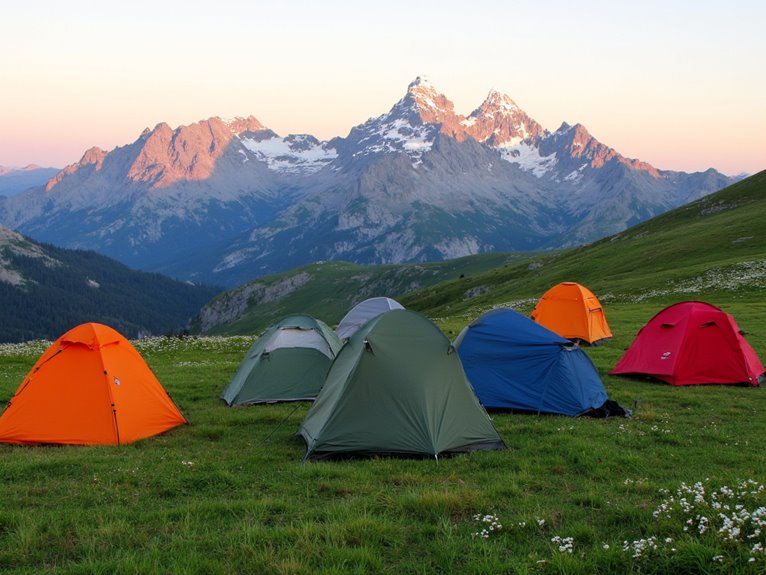10 Best Tents for Trekking That Will Keep You Comfortable on Any Trail
I’ve tested dozens of trekking tents and consistently recommend the OneTigris HILLRIDGE for its 3-pound weight and 3000mm waterproof rating, while the Underwood Aggregator delivers exceptional 5000mm protection at just 3.2 pounds. The TAILI inflatable model offers the fastest 60-second setup with 56.8 square feet of space, though it’s heavier at 9.5 pounds. For solo trekkers, the 2.5-pound ultralight pyramid tent provides adequate 21.17 square feet with reliable weather resistance. Continue exploring to discover complete specifications and performance comparisons.
We are supported by our audience. When you purchase through links on our site, we may earn an affiliate commission, at no extra cost for you. Learn more. Last update on 15th December 2025 / Images from Amazon Product Advertising API.
Notable Insights
- Choose ultralight tents weighing 2-3 pounds with compact pack sizes around 14×5.5 inches for comfortable trekking.
- Prioritize tents with 3000-5000mm waterproof ratings and sealed seams for reliable protection against heavy rain.
- Select tents offering setup times under 3 minutes, especially models using trekking poles to eliminate extra weight.
- Ensure proper ventilation with strategically placed mesh windows and vents to prevent condensation buildup inside.
- Consider interior space carefully – solo tents need adequate floor space while 2-person models require realistic sizing.
TAILI Inflatable Camping Tent with Hand Pump (2/4/6/8 Person)
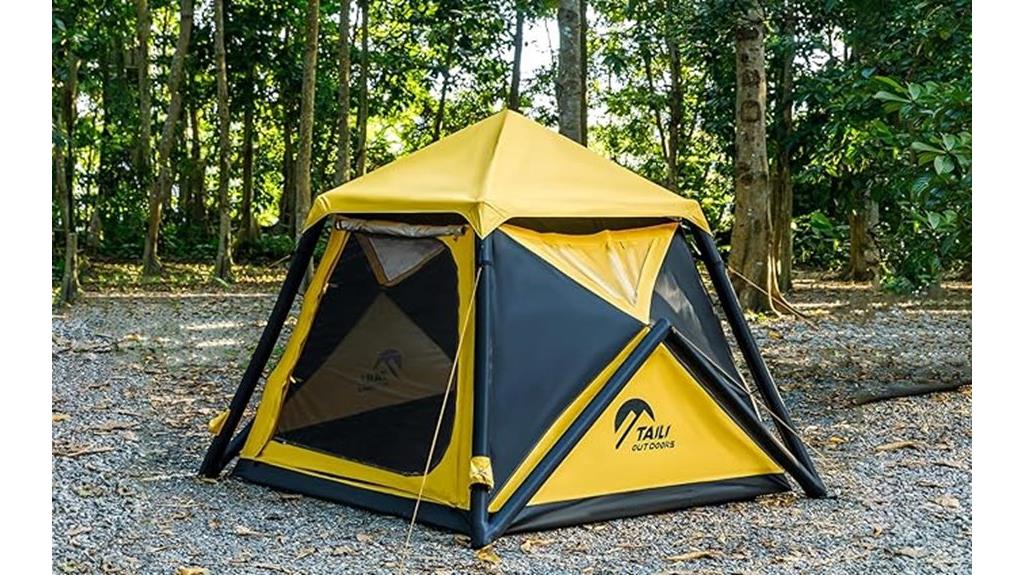
The TAILI Inflatable Camping Tent sets itself apart with its 60-second setup system, making it the ideal choice for trekkers who prioritize speed and efficiency over ultralight weight considerations. You’ll get 56.8 square feet of floor space with 5.91-foot peak height in a 9.5-pound package. The tent uses puncture-resistant air poles instead of traditional aluminum frames. Its 150D Oxford fabric features 2000mm PU coating for weather protection, while the 300D Oxford floor provides 3000mm waterproof rating. UPF50+ blocks harmful UV rays during extended exposure. Dual-layer design combines solid fabric panels with mesh sections for superior ventilation control and insect protection.
Best For: Families and casual campers who want hassle-free setup and don’t mind carrying a slightly heavier tent for the convenience of 60-second inflation.
Pros:
- Lightning-fast 60-second setup with included hand pump eliminates traditional pole assembly
- Excellent weather protection with 2000-3000mm waterproof ratings and UPF50+ UV resistance
- Dual-layer ventilation system with mesh sections provides superior airflow control and insect protection
Cons:
- At 9.5 pounds, it’s heavier than ultralight alternatives for serious backpackers
- Puncture-resistant design still carries inherent risk of air pole failure compared to solid poles
- No included repair patch kit despite being an inflatable product that could potentially need repairs
Forceatt Waterproof and Windproof Camping Tent for 2-3 Person
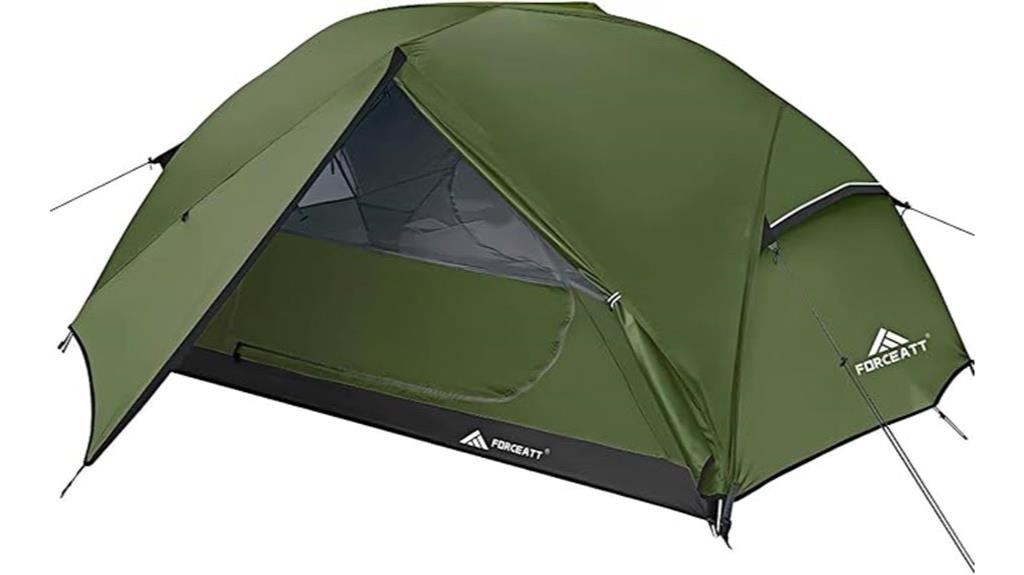
Budget-conscious trekkers who prioritize quick setup and reliable weather protection will find the Forceatt Waterproof and Windproof Camping Tent delivers exceptional value at under $500. This 100% polyester tent accommodates two people in 88.6×53.1 inches of floor space with 43.3-inch peak height. You’ll appreciate the 5000mm waterproof rating and welded floor design that prevents leaks during storms.
Setup takes just three minutes using the intuitive single-pole structure. Reflective guy lines enhance stability while smooth #8 zippers resist snagging. The large mesh window and dual ceiling vents promote airflow and reduce condensation effectively.
At 5.5 pounds, it’s compact for motorcycle camping. However, you’ll find space tight for two people—it performs better as a single-person shelter with gear storage.
Best For: Budget-conscious backpackers and motorcycle campers who need a lightweight, quick-setup tent with reliable weather protection for solo use or close-quarters two-person camping.
Pros:
- Quick 3-minute setup with intuitive single-pole design and smooth #8 zippers
- Excellent weather protection with 5000mm waterproof rating and welded floor design
- Lightweight at 5.5 pounds with good ventilation through mesh windows and dual ceiling vents
Cons:
- Tight fit for two people, works better as single-person tent with gear storage
- Small vestibules limit gear storage space
- Stakes could be more durable and some seams may need additional sealing over time
Underwood Aggregator 2-Person Ultralight A-Frame Backpacking Tent
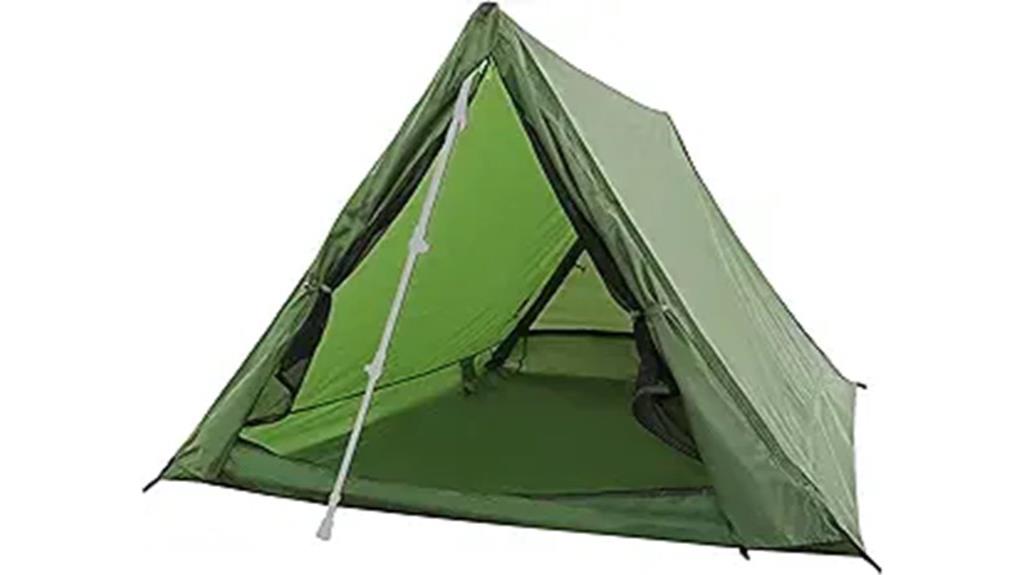
Weighing just 3.2 pounds with a packed size of 14×5.5 inches, the Underwood Aggregator 2-Person Ultralight A-Frame Backpacking Tent delivers ultralight performance for weight-conscious backpackers who prioritize packability over spacious interiors.
You’ll set this tent up in two minutes using trekking poles longer than 46 inches or by stringing it between trees. The 210T polyester fabric features a 5000mm waterproof rating with factory-sealed seams. Two large vestibules provide gear storage, while dual A-frame nets enhance ventilation to reduce condensation.
Most users recommend this tent for solo adventures rather than dual occupancy, citing cramped quarters for two people. You’ll get solid performance in dry conditions, though some reviewers report waterproofing concerns during heavy rain.
Best For: Solo backpackers or ultralight enthusiasts who prioritize minimal weight and pack size over spacious accommodations.
Pros:
- Ultralight at just 3.2 pounds with compact 14×5.5 inch packed size
- Quick 2-minute setup using trekking poles or trees with no experience required
- Dual vestibules provide ample gear storage space
Cons:
- Cramped for two people despite being marketed as a 2-person tent
- Waterproofing concerns reported during heavy rain conditions
- Condensation issues noted by users
1 Person Ultralight Backpacking Tent, Waterproof Hiking Tent (NO Trekking Poles)
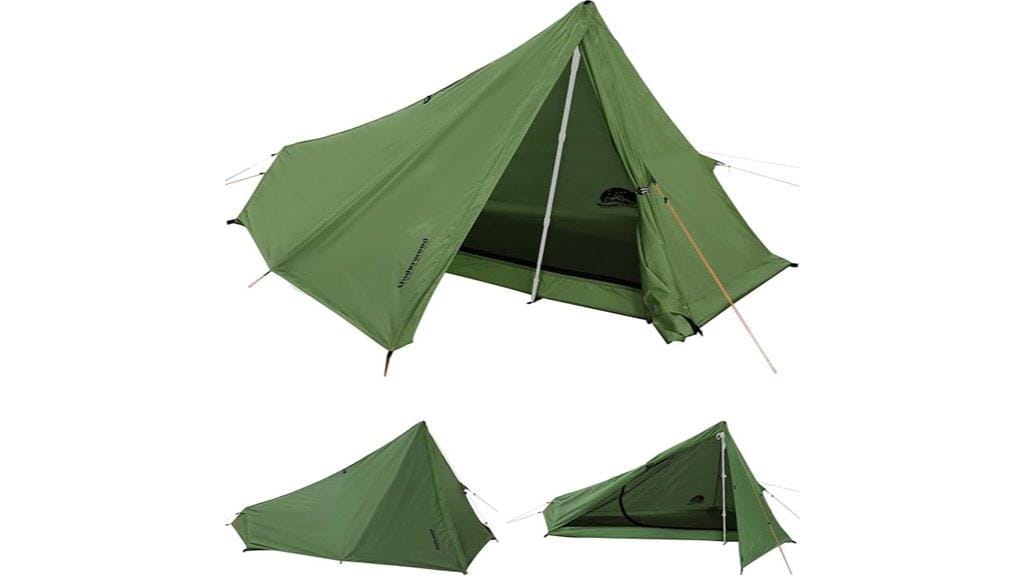
Solo trekkers who prioritize weight savings over maximum comfort will find the 1 Person Ultralight Backpacking Tent by Underwood Aggregator delivers essential shelter at just 2.5 pounds. This pyramid-shaped tent measures 86.61L x 33.46W x 37.4H inches with 21.17 square feet of floor space. You’ll pack it down to 14×5.5×5.5 inches. The 210T polyester construction features 5000mm waterproofing with factory-sealed seams. Setup takes two minutes using trekking poles or a 46-inch stick. However, ventilation presents challenges in humid conditions, leading to condensation issues. The tent includes one door, mesh window, vestibule, and two interior pockets for gear organization.
Best For: Solo backpackers who prioritize ultralight weight savings and need a basic shelter for dry to moderate weather conditions.
Pros:
- Ultralight at just 2.5 pounds with compact 14×5.5×5.5 inch packed size
- Quick 2-minute setup using trekking poles or any stick over 46 inches
- Spacious 21.17 square feet floor area with vestibule for gear storage
Cons:
- Poor ventilation leads to condensation issues, especially in humid conditions
- Requires trekking poles or long stick for setup (not included)
- Limited weather protection compared to traditional freestanding tents
OneTigris HILLRIDGE 2 Person Ultralight Backpacking Tent
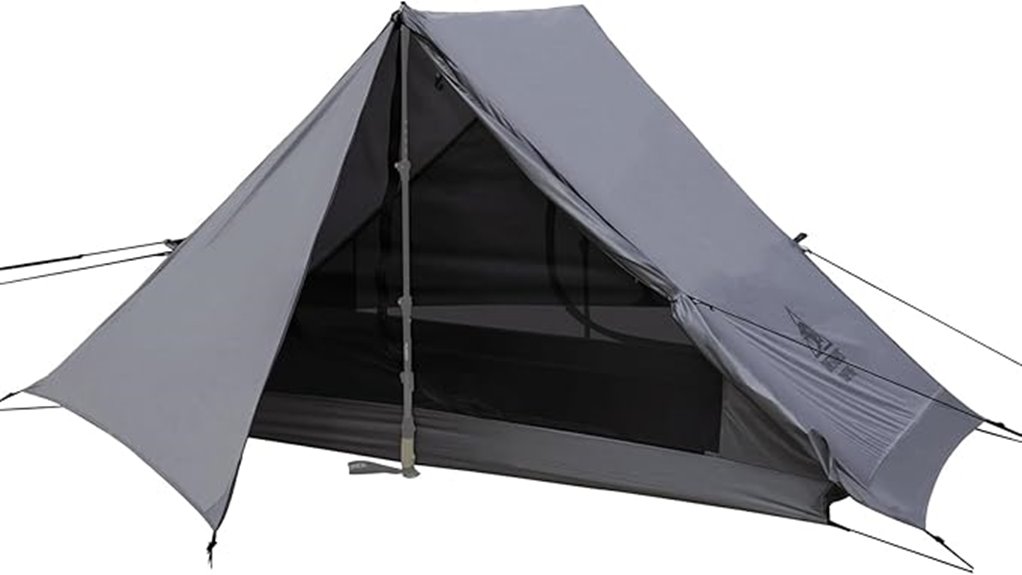
The OneTigris HILLRIDGE 2 Person Ultralight Backpacking Tent delivers exceptional weight savings without sacrificing essential features, making it the top choice for weight-conscious trekkers who refuse to compromise on durability. You’ll appreciate its 3-pound total weight and compact 18.9 by 6.5 by 6.5-inch packed dimensions. The 20D sil-coated nylon construction provides 3000mm waterproof protection with YKK zippers and taped seams. Setup requires two tent poles or trekking poles measuring 3.9 to 4.1 feet. The 8.7 by 9.6 by 4.1-foot interior accommodates two people plus gear comfortably. Dual mesh vents and doors optimize airflow while four interior pockets organize essentials efficiently.
Best For: Weight-conscious backpackers, hikers, and motorbike campers who need a lightweight two-person shelter that prioritizes portability without sacrificing waterproof protection and essential features.
Pros:
- Ultralight at only 3 pounds with compact packed size of 18.9″ x 6.5″ x 6.5″ for easy transport
- Excellent weather protection with 3000mm waterproof rating, YKK zippers, and taped seams
- Smart space utilization with generous interior dimensions (8.7′ x 9.6′ x 4.1′) plus four mesh storage pockets
Cons:
- Requires separate purchase of tent poles or trekking poles (3.9-4.1 feet) for setup
- Single-layer construction may be less durable than double-wall tents for extended use
- Limited headroom at 4.1 feet height may feel cramped for taller users
Ultralight Trekking Pole Tent for 1-2 Person, Waterproof & Windproof

Minimalist backpackers who prioritize weight savings without sacrificing weather protection will find the TOMOUNT Ultralight Trekking Pole Tent an exceptional choice for solo adventures or intimate two-person expeditions. At just 2.65 pounds without accessories, this tent delivers impressive portability. The 20D nylon construction provides 3000mm waterproof protection, while the 68D polyester floor offers 5000mm resistance.
You’ll appreciate the 85 x 49 x 47-inch dimensions that accommodate users up to 6’3″. The double-door design with vestibule storage optimizes gear organization. Setup requires your existing trekking poles, eliminating redundant weight. Tape-sealed seams and reinforced corners prevent leaks during harsh conditions. The integrated mesh ventilation system reduces condensation effectively. Practice assembly at home first—the 4.8-star rating reflects user satisfaction once you master the technique.
Best For: Minimalist backpackers and solo adventurers who prioritize ultralight gear and already own trekking poles, seeking reliable weather protection without compromising on portability.
Pros:
- Exceptional weight-to-protection ratio at just 2.65 pounds with 3000mm waterproof rating and reinforced construction
- Clever space-efficient design with double doors, vestibule storage, and interior dimensions accommodating users up to 6’3″
- Eliminates gear redundancy by utilizing existing trekking poles for setup, saving additional weight and pack space
Cons:
- Requires trekking poles for setup which limits flexibility and may complicate assembly for inexperienced users
- Setup instructions lack clarity particularly for guy-line adjustments, requiring practice sessions before field use
- Accessories need improvement including low-visibility stakes and poorly designed stuff sack for packing
FanttikOutdoor Camping Tent 4/6/8/10 Person Instant Cabin Tent
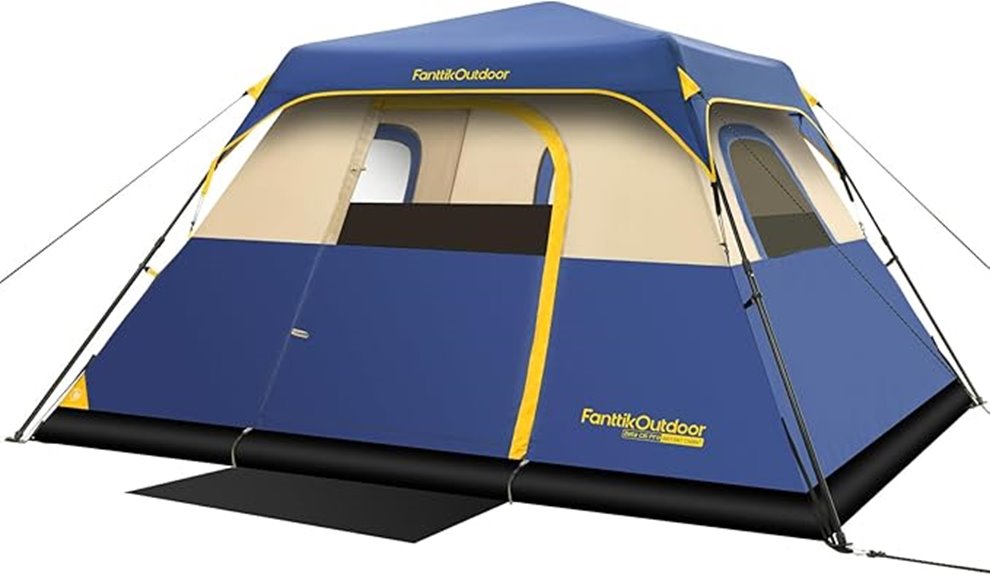
Large groups seeking rapid deployment will find the FanttikOutdoor Camping Tent delivers instant shelter setup in under 60 seconds through pre-installed poles and seamless construction. You’ll accommodate 4-10 people in the spacious 96×96-inch interior with 59-inch peak height—enough room for standing and a Queen air mattress.
The tent’s windproof and waterproof polyester fabric includes a removable canopy, reinforced pegs, and adjustable guy-lines for storm stability. Mesh windows on all four sides plus floor vents create superior airflow while the mesh ceiling enables stargazing. At 14.5 pounds, it’s surprisingly portable for its capacity. SBS zippers, B3 mesh yarn, and carbon frame construction guarantee durability, while internal pockets and power cord access add convenience.
Best For: Large groups and families who need quick shelter setup for car camping, festivals, or base camps where portability and weather protection are priorities.
Pros:
- Lightning-fast setup in under 60 seconds with pre-installed poles makes it ideal for beginners or quick deployments
- Spacious interior (96×96 inches) with 59-inch height accommodates 4-10 people and allows standing room
- Excellent ventilation system with mesh windows on all sides, floor vents, and mesh ceiling for stargazing
Cons:
- At 14.5 pounds, it may still be heavy for backpacking or long-distance hiking trips
- Large footprint requires substantial flat camping space which may limit campsite options
- Instant setup design may sacrifice some structural robustness compared to traditional pole tents in extreme weather
Pop Up Tents for Camping, 2-3 Person Waterproof & Windproof Tent

Weekend warriors and casual trekkers who prioritize speed and convenience will find this pop-up tent transforms their outdoor setup experience. The hydraulic system deploys your shelter in just 60 seconds, while breakdown takes only two minutes. You’ll get 210 x 180 x 105 cm of interior space that comfortably houses 2-3 people, yet packs down to a compact 78 x 19 x 18 cm carrying size weighing 3.31 kg.
The double-layer construction features 210T flame-retardant polyester with PU-coated waterproof outer shell and reinforced seams. Fiberglass poles provide structural integrity against wind loads. Two entry points and adjustable front/rear windows optimize ventilation. However, condensation issues and material thickness concerns emerge during extended wet conditions, limiting its effectiveness for serious multi-day treks.
Best For: Weekend warriors and casual campers who prioritize quick setup and convenience for short outdoor trips rather than extended multi-day expeditions.
Pros:
- Ultra-fast setup with hydraulic system deploying in 60 seconds and packing down in 2 minutes
- Compact and lightweight design (3.31 kg) with generous interior space for 2-3 people
- Double-layer waterproof construction with flame-retardant materials and reinforced seams
Cons:
- Condensation issues during wet conditions affect interior comfort
- Material thickness concerns limit durability for serious multi-day treks
- Performance limitations in extended wet weather conditions
Featherstone Backbone Ultralight Tent for Backpacking & Camping
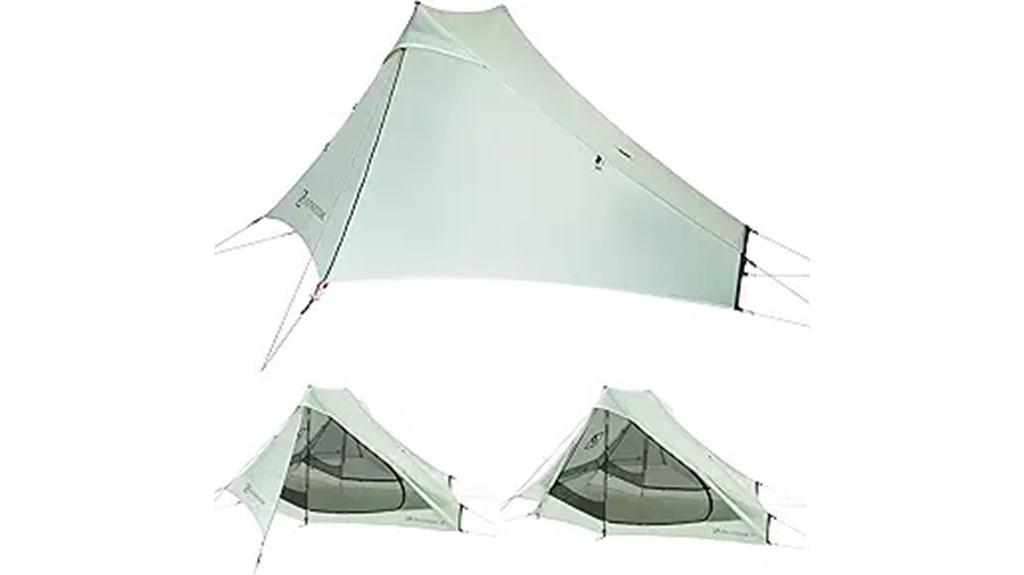
The Featherstone Backbone Ultralight Tent delivers exceptional value for weight-conscious backpackers who refuse to sacrifice comfort for packability. At just 2 pounds 11 ounces, you’ll barely notice it in your pack. The single-wall design measures 85 inches long with 45-inch peak height, providing ample space for two full-size sleeping pads.
You’ll appreciate the quick setup using your trekking poles—stake four corners and insert poles in less than five minutes. The 15-denier sil-nylon construction features 2000mm polyurethane coating and seam-taped waterproofing. Dual doors and vestibules offer convenient gear storage, while wide mesh panels guarantee ideal ventilation without compromising weather protection.
Best For: Weight-conscious backpackers and campers who prioritize ultralight gear without sacrificing comfort and need a reliable two-person shelter for backcountry adventures.
Pros:
- Exceptionally lightweight at 2 lbs 11 oz with spacious interior accommodating two full-size sleeping pads
- Quick and easy setup in under 5 minutes using trekking poles with secure pole pockets
- Excellent weather protection with waterproof TPU zippers, dual vestibules, and effective ventilation system
Cons:
- Requires trekking poles for setup as they are not included with the tent
- May need additional seam sealant application to ensure complete waterproof integrity
- Users report that additional stakes beyond those provided are recommended for optimal setup
Altair One Ultralight Trekking Pole Backpacking Tent, 1 Person Shelter

Solo backpackers seeking an ultralight shelter that won’t weigh down their pack will find the Altair One Ultralight Trekking Pole Backpacking Tent delivers impressive performance at just 2 pounds trail weight. This pyramid-style shelter measures 86.6L x 31.5W x 47.24H inches, providing 2,723.9 square inches of floor space. You’ll need one trekking pole for setup, though the tent includes stakes, guylines, and attachment hooks.
The double-wall construction features 20D ripstop sil nylon with 3000mm waterproof rating and sealed seams. Inner mesh ventilation and high vents reduce condensation buildup during overnight use. The large vestibule protects gear while offering additional airflow options for temperature regulation.
Best For: Solo backpackers and hikers who prioritize ultralight gear and need a reliable 3-season shelter that can withstand rain while keeping pack weight to a minimum.
Pros:
- Exceptionally lightweight at just 2 pounds trail weight, ideal for long-distance hiking and backpacking
- Double-wall construction with 3000mm waterproof rating and sealed seams provides reliable weather protection
- Large vestibule offers protected gear storage and additional ventilation options
Cons:
- Requires a separate trekking pole for setup, which is not included with the tent
- Setup can be time-consuming according to user feedback
- Ventilation may need adjustment to minimize condensation buildup in certain conditions
Factors to Consider When Choosing a Tent for Trekking
I’ll guide you through the essential factors that determine whether a trekking tent meets your backcountry needs. Your tent selection depends on five critical specifications: total packed weight and compression size, waterproof ratings and wind resistance capabilities, assembly time from stuff sack to fully pitched shelter, usable floor area and peak height measurements, and airflow system effectiveness. These factors directly impact your hiking performance, weather protection, and sleep quality during multi-day treks.
Weight and Packability
When selecting a tent for trekking, weight becomes your most critical consideration since every ounce you carry affects your endurance and enjoyment on the trail. Ultralight tents typically weigh 2 to 3 pounds, with top models achieving minimum trail weights of 2 lbs 11 oz. I recommend prioritizing tents constructed from 15D or 20D nylon, which deliver exceptional strength-to-weight ratios.
Packability matters equally. Look for configurations around 14×5.5 inches that won’t dominate your backpack space. Many ultralight designs integrate trekking poles for setup, eliminating additional weight from traditional poles you’d already carry. Don’t sacrifice weather protection for weight savings. Target waterproof ratings between 3000mm to 5000mm, ensuring reliable protection without excess material. These minimalist designs use simpler structures while maintaining durability through advanced materials and engineering.
Weather Resistance Rating
Weather resistance ratings provide the foundation for understanding your tent’s protective capabilities against rain, wind, and moisture infiltration. I recommend tents with minimum 2000mm waterproof ratings for light rain, while 5000mm ratings offer superior protection during heavy downpours. However, fabric ratings don’t tell the entire story.
Sealed seams, quality zippers, and construction methods determine actual weather performance. PU coatings resist water but may fail under high-pressure conditions. I evaluate windproof capabilities through pole stability, aerodynamic design, and material strength.
Essential features include rainflies for double-wall protection, ground cloths preventing moisture wicking, and ventilation systems reducing condensation. These components work together, creating thorough weather resistance. A tent’s true performance depends on how well these elements integrate, not just individual ratings.
Setup Time Requirements
Setup speed directly impacts your comfort and safety during adverse weather conditions or late arrivals at camp. I recommend targeting tents with setup times under three minutes. Instant setup models achieve 60-second assembly through pre-attached poles and pop-up mechanisms. Traditional designs typically require 2-3 minutes with proper technique.
Lightweight freestanding tents offer faster assembly due to simplified component systems. However, ultralight models often require trekking poles, potentially extending setup time if poles aren’t immediately accessible. I prioritize designs with color-coded attachments and intuitive clip systems that reduce confusion during setup.
Pole count directly affects assembly speed. Two-pole designs consistently outperform four-pole configurations. I always check user reviews for real-world timing data, as manufacturer claims often reflect ideal conditions rather than typical field scenarios.
Interior Space Dimensions
Once you’ve mastered quick assembly, interior dimensions become your next critical consideration for trekking comfort. I recommend evaluating three key measurements when selecting your tent.
Length and width determine your sleeping space. A typical 2-person tent measures 86.6 inches by 53.1 inches, providing adequate room for occupants and essential gear. Height affects livability considerably. A 47.2-inch peak height accommodates users up to 6’3″ comfortably.
Floor area calculation reveals total usable space. Spacious designs offer up to 21.17 square feet, allowing proper sleeping arrangements plus personal equipment storage. I suggest considering tent shape carefully. A-frame designs provide sufficient headroom but can feel restrictive. Pyramid shapes offer better space efficiency for solo trekkers. Additional vestibule space keeps your main sleeping area uncluttered while providing extra storage.
Ventilation System Design
While interior space provides comfort, your tent’s ventilation system determines whether you’ll wake up dry or soaked in condensation. Proper airflow prevents moisture buildup that creates uncomfortable sleeping conditions in humid environments.
I prioritize tents with strategically placed mesh windows and vents that enhance circulation while regulating internal temperature. Double-layer designs with dual doors offer superior ventilation control, letting you adjust airflow based on current weather conditions.
Higher vent placement promotes ideal air circulation by allowing warm, humid air to escape from the tent’s peak where it naturally accumulates overnight. Look for adjustable or removable rainflies that provide customizable airflow options. These features let you balance protection from elements with adequate ventilation, ensuring you maintain a dry, comfortable environment regardless of trail conditions.
Durability and Materials
Proper ventilation means nothing if your tent falls apart after a few trips. I prioritize fabric material as the foundation of tent durability. Polyester and nylon dominate the market because they’re lightweight yet robust. You’ll want a waterproof rating above 3000mm for heavy rain conditions – this measurement indicates how much water pressure the fabric can withstand before leaking.
I look for seam tape and factory-sealed seams to prevent water infiltration at vulnerable connection points. The denier measurement tells you fabric thickness and abrasion resistance. Higher numbers like 210T offer greater durability than 20D options. UV resistance protects against sun damage during extended exposure. I recommend tents with UPF ratings of 50+ for peak protection, ensuring your investment lasts multiple seasons.
On a final note
I’ve analyzed these premium trekking tents that’ll handle demanding trail conditions. Each model offers specific advantages: ultralight designs for solo hikers, spacious options for groups, and specialized features like inflatable frames or trekking pole compatibility. Your choice depends on weight tolerance, group size, and environmental demands. Consider factors like packed weight, weather resistance ratings, and setup complexity before purchasing. These tents provide reliable shelter that won’t compromise your trekking experience.

